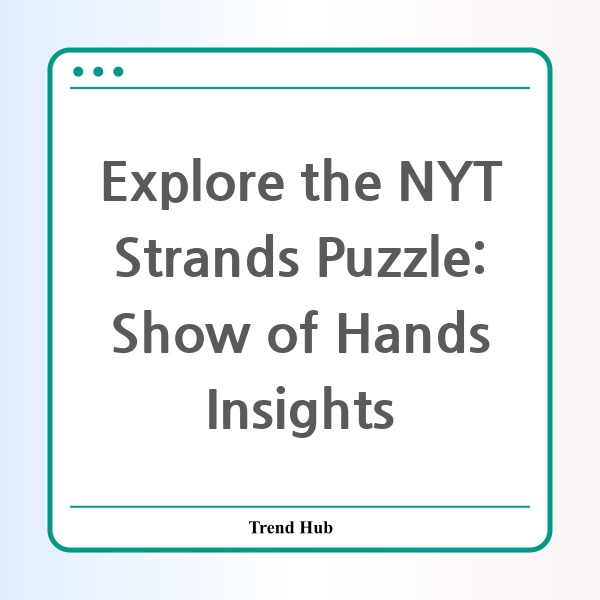* This website participates in the Amazon Affiliate Program and earns from qualifying purchases.

Have you ever tried solving a puzzle and felt like you were more confused at the end than when you started? If you enjoy brain teasers and word games, the New York Times’ Strands puzzle might be just what you need. It’s an innovative twist on classic word searches that challenges your vocabulary and lateral thinking skills. Let’s dive into today’s theme, which is all about a "Show of Hands." Get ready to explore hints, spangrams, and answers!
The NYT Strands puzzle presents a 6x8 grid of letters daily, where your aim is to find words that connect through a common theme. As players uncover these theme words, they’ll also search for a special word known as a spangram. This word serves as a bridge connecting two sides of the grid and helps players ascertain the underlying theme. When you highlight a theme word, it turns blue, while the spangram is highlighted in yellow. The best part? Every letter in the grid is utilized in either a theme word or the spangram, calling for strategic letter connections horizontally, vertically, or even diagonally.
Today, I’ll walk you through the hints that lead players to the theme and unveil all the answers. The official hint for today’s puzzle is: Show of Hands. To give you a nudge in the right direction, I've also included my own unofficial hint: “Punch and Judy.”
Now, let’s clarify the theme. "Show of Hands" cleverly refers to *types of puppets.* From marionettes to shadow puppets, this theme covers a range of interactive performance styles. It may seem tricky at first, especially if you’re grasping for terms like "wrist" or "thumb," which might come to mind first when thinking about hands. But the clues point to the fascinating world of puppetry.
Today’s spangram is PUPPETMASTER, which encapsulates the essence of control over puppets. With this key term, you can unlock the puzzle and begin connecting the dots. The answers you’ll be looking for within the grid include:
- FINGER
- SOCK
- GLOVE
- STICK
- SHADOW
- MARIONETTE
So, how do these terms connect? Let’s break them down:
- FINGER: Often used in puppet manipulation, particularly in finger puppets.
- SOCK: Refers to sock puppets that are easily made and manipulated by hand.
- GLOVE: Represents glove puppets, which require the puppeteer to wear a glove with a puppet on it.
- STICK: Used in traditional stick puppetry where the puppet is attached to a stick for easy maneuvering.
- SHADOW: Indicates shadow puppets, which are projected images on a screen.
- MARIONETTE: A classic type of puppet operated using strings.
What a fascinating world of creativity we’ve uncovered today! The Strands puzzle not only enhances vocabulary but also ignites our curiosity about various forms of art and entertainment. Each day brings a new challenge and a multitude of possibilities. Whether you find success with hints or struggle through each clue, the experience of engaging in a word puzzle like this one is worthwhile.
Next time you sit down to tackle the NYT Strands, remember the theme and hints we covered today. You have the tools to string together those elusive words effectively. Happy puzzling, and may you uncover more exciting themes in the upcoming puzzles!
* This website participates in the Amazon Affiliate Program and earns from qualifying purchases.